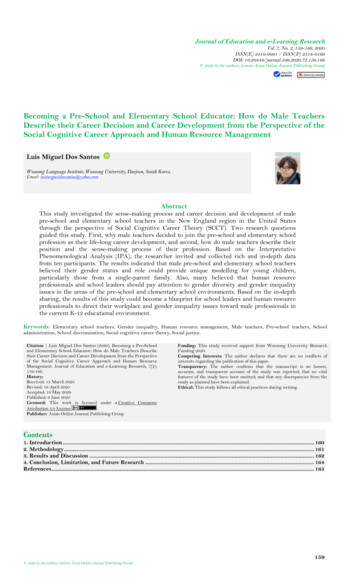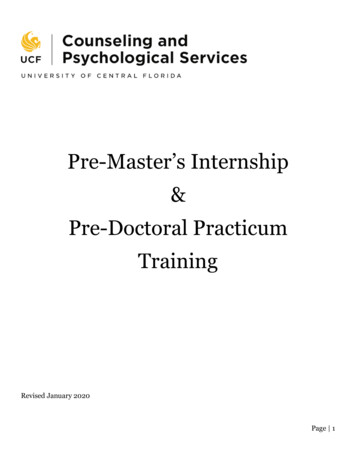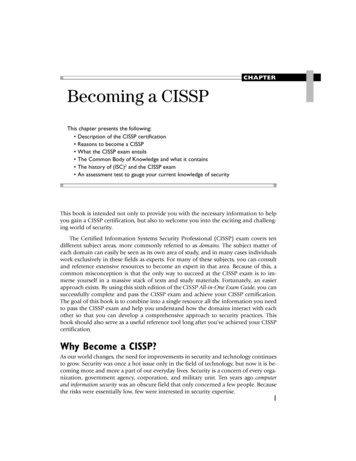
Transcription
Journal of Education and e-Learning ResearchVol. 7, No. 2, 159-166, 2020ISSN(E) 2410-9991 / ISSN(P) 2518-0169DOI: 10.20448/journal.509.2020.72.159.166 2020 by the authors; licensee Asian Online Journal Publishing GroupBecoming a Pre-School and Elementary School Educator: How do Male TeachersDescribe their Career Decision and Career Development from the Perspective of theSocial Cognitive Career Approach and Human Resource ManagementLuis Miguel Dos SantosWoosong Language Institute, Woosong University, Daejeon, South Korea.AbstractThis study investigated the sense-making process and career decision and development of malepre-school and elementary school teachers in the New England region in the United Statesthrough the perspective of Social Cognitive Career Theory (SCCT). Two research questionsguided this study. First, why male teachers decided to join the pre-school and elementary schoolprofession as their life-long career development, and second, how do male teachers describe theirposition and the sense-making process of their profession. Based on the InterpretativePhenomenological Analysis (IPA), the researcher invited and collected rich and in-depth datafrom ten participants. The results indicated that male pre-school and elementary school teachersbelieved their gender status and role could provide unique modelling for young children,particularly those from a single-parent family. Also, many believed that human resourceprofessionals and school leaders should pay attention to gender diversity and gender inequalityissues in the areas of the pre-school and elementary school environments. Based on the in-depthsharing, the results of this study could become a blueprint for school leaders and human resourceprofessionals to direct their workplace and gender inequality issues toward male professionals inthe current K-12 educational environment.Keywords: Elementary school teachers, Gender inequality, Human resource management, Male teachers, Pre-school teachers, Schooladministration, School discrimination, Social cognitive career theory, Social justice.Citation Luis Miguel Dos Santos (2020). Becoming a Pre-Schooland Elementary School Educator: How do Male Teachers Describetheir Career Decision and Career Development from the Perspectiveof the Social Cognitive Career Approach and Human ResourceManagement. Journal of Education and e-Learning Research, 7(2):159-166.History:Received: 13 March 2020Revised: 16 April 2020Accepted: 19 May 2020Published: 9 June 2020Licensed: This work is licensed under a Creative CommonsAttribution 3.0 LicensePublisher: Asian Online Journal Publishing GroupFunding: This study received support from Woosong University ResearchFunding 2020.Competing Interests: The author declares that there are no conflicts ofinterests regarding the publication of this paper.Transparency: The author confirms that the manuscript is an honest,accurate, and transparent account of the study was reported; that no vitalfeatures of the study have been omitted; and that any discrepancies from thestudy as planned have been explained.Ethical: This study follows all ethical practices during writing.Contents1. Introduction . 1602. Methodology . 1613. Results and Discussion . 1624. Conclusion, Limitation, and Future Research . 164References . 165159 2020 by the authors; licensee Asian Online Journal Publishing Group
Journal of Education and e-Learning Research, 2020, 7(2): 159-166Contribution of this paper to the literatureThis paper contributes to the fields of organisational leadership, school human resource management,school inequality, and social justice.1. IntroductionThe shortage of qualified pre-school and elementary school teachers in the United States is a serious problemacross all 50 American states, Washington District Columbia, and several overseas territories. The problem isparticularly prevalent in rural communities which are less attractive to both in-service and pre-service teachers(Dos Santos, 2019b; Dos Santos, 2019c; Weiner, 2012; Weiner & Jerome, 2016). According to the United StatesBureau of Labour Statistics, the potential growth of K-12 teachers is around 3 - 4% due to the increasing demandfrom the growing population (Statistics B of Labor, 2020). However, many researchers (Dos Santos, 2016; Skaalvik& Skaalvik, 2017) indicate that teachers are more likely to leave their teaching position and even quit the teachingprofession every year due to stress, workload, financial considerations, and responsibilities (Weiner & Jerome,2016). Due to the unbalanced student-teacher ratio, the teacher human resources shortage continues to be the mainissue for school human resource management.For nearly half a century, human resource professionals, policymakers, and school leaders have encouragedboth secondary school graduates and career changers to enter the teaching profession (Chambers, 2002). However,pre-school and elementary school education does not seem to be a potential, attractive career development for maleteachers wanting to provide educational services to young children. Due to social, cultural, and gender biases in thefield of pre-school and elementary school education, the public members usually consider pre-school andelementary school systems to have a female bias due to the nursery and caring orientation. Although gender andsocial roles should be taught at an early age, the social and gender biases always limit the enrolment andparticipation of potential male pre-school and elementary school teachers from joining the profession (Yu, Wang,Zhai, Dai, & Yang, 2015). Many parents, school leaders, policymakers, and educational researchers advocated thedesires of male pre-school and elementary school teachers. The encouragements did not increase the overallenrolments of male students into the programme and profession (Erden, Ozgun, & Ciftci, 2011).Pre-school and elementary school teachers play significant roles in helping early age children’s performance,physical development, and cognitive growth (Erden et al., 2011). Students could learn different skills and abilitiesfrom male and female teachers as their conducts, teaching and learning strategies, mental stages, and social roleswere not the same. In other words, the knowledge bases and thought processes of both male and female teacherswere different (Hansen & Mulholland, 2005; Marks, 2000). Although gender bias is not a limitation for careerselection in the United States and other westernised countries and regions, most male individuals do not choosepre-school and elementary school teaching as their life-long career decision and career development.Research indicated that for children from single-parent families, particularly children from single-motherfamilies, young children’s growth can be beneficial due to the social and gender roles of male pre-school andelementary school teachers (Cameron, 2001). A single-parent family is a common family structure due to social andcultural development over the decades. A large number of children are raised in a single-mother family where thefather’s social and gender role was absent. Therefore, without the understanding of how male individuals work in afamily, many boys do not understand the conducts of their male models. Sevier and Ashcraft (2009) indicated thatthe teaching and educational services of male pre-school teachers were not their major concerns. Rather, male preschool teachers provided the social and gender roles and models which female teachers could not do(Sevier &Ashcraft, 2009).Gender inequality (Robinson, McGee, Bentley, Houston, & Botchway, 2016; Yeung, 2011) is another concernin the current educational profession. Many advocated that career development should not be limited due togender. For nearly a century, a large number of NGOs, government agencies, educational institutions, religiousorganisations, and public members have been advocating the working rights of female individuals in the workplace.However, men’s rights in the pre-school profession were not actively addressed. Currently, many (Shek & Wu,2014) suggest that government agencies, business leaders, top-level boards, Congress, and Parliament shouldencourage more female individuals for gender diversity. However, no one has made a parallel suggestion forreforms and improvements in the current pre-school environments.Further discouragements for individuals joining the pre-school profession were the excessive responsibilities,long working hours, social caring commitment, poor starting salary, and potential career development, particularlyfor men who may need to take care of their family (Betoret & Artiga, 2010; Yang, Fan, Chen, Hsu, & Chien, 2018).For the above reasons, after the completion of student-teaching placements and internships, many pre-service, preschool and elementary school teachers will not join the profession. Also, in-service and pre-school teachers left theteaching profession for various reasons (Dos Santos, 2019d; Glutsch & König, 2019; Im, Yoon, & Cha, 2016). For alarge number of reasons, the pre-school and elementary school profession is one of the most challengingprofessions in which to recruit potential teachers, particularly male individuals.1.1. Purpose of the StudyFor nearly half of a century, school human resource management and teacher shortages have been a seriousproblem (Hardman, 2001; Ingersoll, 2001; Weiner & Jerome, 2016). Based on this background, the current studyaims to understand the career decision and career development of ten male pre-school and elementary schoolteachers who have been working in the profession for at least ten years in the New England region in the UnitedStates. Three significant areas were captured for this study, as follows.First, based on the current social, cultural, and educational environment in the United States, the generalpublic, parents, school leaders, and even students advocated that pre-school and elementary school teachers shouldbe female individuals. Based on this information, the researcher explored the reasons why male teachers decided tojoin the pre-school and elementary school profession as their life-long career development.Second, as the numbers of male pre-school and elementary school teachers are fewer than female teachers, theresearcher investigated how male teachers describe their position and the sense-making process of their profession.160 2020 by the authors; licensee Asian Online Journal Publishing Group
Journal of Education and e-Learning Research, 2020, 7(2): 159-166Last but not least, the results of this study captured meaningful data from male pre-school and elementaryschool teachers. The results encouraged school leaders, human resource professionals, policymakers, governmentagencies, department heads, and researchers to reform and improve the current human resource planning andorganisational leadership approach.1.2. Theoretical FrameworkThe Social Cognitive Career Theory (SCCT) is a model that explores, from a career perspective, how academicinterests, choices, and performance influenced peoples’ career decisions (Lent & Brown, 1996; Lent, Brown, &Hackett, 1994). In its development, the theory merged four elements: self-efficacy beliefs from the central notion ofsocial cognitive theory (Bandura, 1986; Bandura & Adams, 1977), outcome expectations, interests, and goals.The theory advocates that people’s career decisions and behaviours are always influenced by both internal andexternal elements, which might include personal and background factors. Personal influences include gender,ethnicity, age, sexual orientation, health status, and place of origin Hackett, Betz, Casas, and Rocha-Singh (1992);Swanson and Gore (2000). Background elements include social networks, school relations, and peer interactions.Peoples’ beliefs could be changed due to various internal and external factors. For example, previous studiesindicated that the career decision and development of international school teachers in remote regions could beinfluenced by social isolation and lack of networking due to the location of the school (Dos Santos. 2019e).Another study proposed that the managerial styles of the school leaders could influence a teacher’s job satisfactionand turnover decision as a network (Dos Santos, 2016). Further, it is worth noting that second-career teachersmight give up their original professions as scientific researchers due to their family and financial commitments(Dos Santos, 2019a).Therefore, peoples’ behaviours could be impacted and altered for different reasons. For this study, theresearcher employed the SCCT (Brown, Steven, & Lent, 2017; Lent & Brown, 1996; Lent et al., 1994; Lent, Lopez,Lopez, & Sheu, 2008; Swanson & Gore, 2000) as the lens used to explore this particular group of male pre-schooland elementary school teachers and to understand their career decision and sense-making process in this femaledominated profession in the United States.2. Methodology2.1. The Application of Interpretative Phenomenological AnalysisThe researcher employed the qualitative research method with the application of the InterpretativePhenomenological Analysis (IPA). The IPA is a useful methodology to collect rich and in-depth data concerningthe inner world, sense-making process, and lived stories of the participants. Researchers (Larkin & Thompson,2011) advocated that the IPA has the epistemological and hermeneutic approaches (Boblin, Ireland, Kirkpatrick, &Robertson, 2013). Researchers and studies with these focuses tend to collect data about the relationship andengagement of the peoples’ social interactions together with their inner world. Three key elements have beensummarised (Larkin & Thompson, 2011): First, peoples’ inner world and understanding always related to their personal experiences and background(Tang & Dos Santos, 2017). For example, an earlier study (Dos Santos, 2016) indicated that peoples’ careerperspectives and decisions could be influenced by their social and external environments and behaviours.As a result, without people’s background and experience, researchers could not seek the performance andunderstanding of their inner world. Second, the IPA always seeks to understand individuals’ social and inner worlds from exploring theirconversational, oral, cultural, social, environmental, mental, and physical backgrounds and experience(Smith & Osborn, 2003). These approaches allow the researchers to obtain meaningful data with which tointerpret the social and inner world of the individuals. Third, the IPA has a narrow focus on a particular situation or social phenomenon. In other words, theresearchers tend to seek relationships and engagements with something specific or unique to the peoples’backgrounds and experience (Brocki & Wearden, 2006).2.2. Brief Background of the ParticipantsTen in-service, male pre-school and elementary school teachers (N 10) with at least ten years of teachingexperience were invited to participate in this study.Table-1. Demography of the participants.NameTeacher #1Teacher #2Teacher #3Teacher #4Teacher #5Teacher #6Teacher #7Teacher #8Teacher #9Teacher #10Teaching mentaryYears of Experience13201814112315202125Highest QualificationMaster’s degreeMaster’s degreeMaster’s degreeMaster’s degreeMaster’s degreeDoctorateMaster’s degreeMaster’s degreeMaster’s degreeDoctorateAll participants agreed to engage. All the participants were first-career teachers without any other professionalexperiences. Table 1 above outlines the demographics of the participants.161 2020 by the authors; licensee Asian Online Journal Publishing Group
Journal of Education and e-Learning Research, 2020, 7(2): 159-1662.3. Data CollectionTwo sessions of semi-structured, one-on-one, private interviews were performed to collect meaningful datafrom the participants (Seidman, 2013). For each interview session, the researcher aimed to capture the careerdecision and career development of the participants, and examine how they described their role as male pre-schooland elementary school teachers in female-dominated professions. In short, each interview session had separatethemes of interview questions. The first interview session addressed why male teachers decided to join the preschool and elementary school profession as their life-long career development. The second interview sessionrelated to how male teachers describe their position and the sense-making process of their profession. Eachinterview hosted approximately 120 minutes per person.2.4. Data AnalysisThemes, subthemes, and categories were captured and grouped together after the data collection procedure.The general inductive approach (Tang & Dos Santos, 2017; Thomas, 2006) was employed to analyse the interviewdata. Due to the nature of this study and the data collection procedures (i.e. in-depth interview and lived storiessharing), a large number of conversations and sharings were collected. Therefore, the researcher needed to employthe open-coding technique to narrow down the large volume of information into the first-level (Creswell, 2014;Merriam, 2009) themes and subthemes. After the researcher categorised all the information into several sections,the researcher needed to employ the axial-coding technique (Creswell, 2014; Merriam, 2009). Subsequent to this,the second-level themes and subthemes were merged. As a result, two themes and four subthemes were categorisedfor reporting.2.5. Human Subjects ProtectionProtecting the personal information of the participants was a crucial factor of this study. Therefore, theresearcher locked all the unsigned and signed agreements, personal details, audio-recordings, transcripts,computers, and related materials into a password-protected cabinet. Only the researcher had the rights to open andread the information. After the data analysis procedure, the researcher deleted and destroyed the related materialsimmediately due to privacy laws.For further human subject protection, participants’ workplaces (i.e. pre-school and elementary schools), ages,and names were masked. The population of male teachers in the fields of pre-school and elementary schools werelimited. The researcher needed to protect all the related information to protect their social networking and jobopportunities.3. Results and DiscussionAfter 20 rounds of in-depth, one-to-one participant interviews, the researcher collected a substantial amount ofmeaningful data from ten in-service. male pre-school and elementary school teachers. Each participant received thesame protocol and interview questions to prepare and answer. Thus, the semi-structured interviews outlined thedirections which the researcher tended to respond to the research questions and purposes of this study. Based onthe data and with the guideline of the SCCT (Brown et al., 2017; Lent & Brown, 1996; Lent et al., 1994; Lent et al.,2008; Swanson & Gore, 2000) the researcher categorised two themes and four subthemes, outlined in Table 2.Table-2. Themes and subthemes.Themes and Subthemes1. Establishing the male modelling at pre-school an
Yang, Fan, Chen, Hsu, & Chien, 2018). For the above reasons, after the completion of student-teaching placements and internships, many pre-service, pre-school and elementary school teachers will not join the profession. Also, in-











